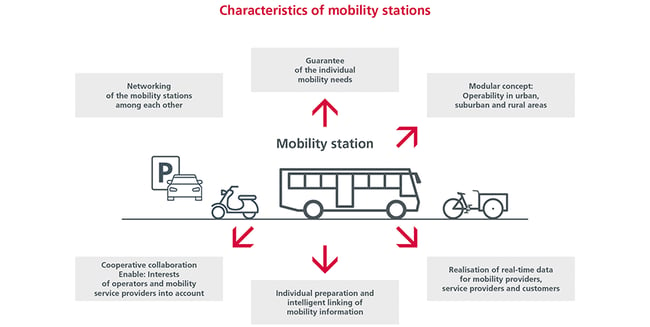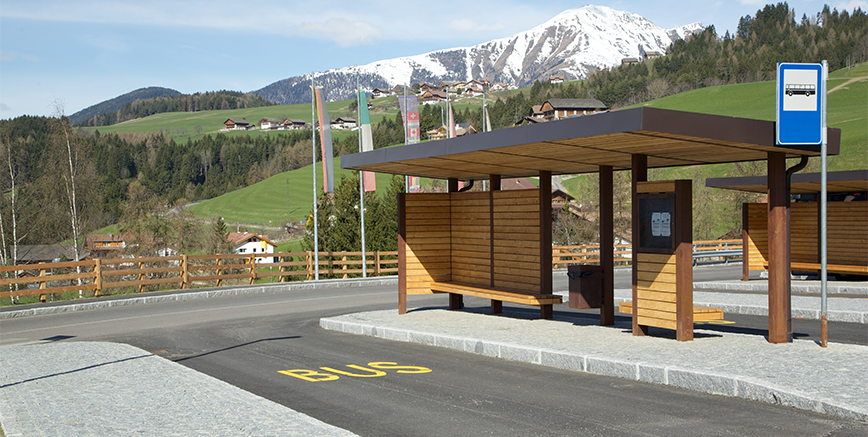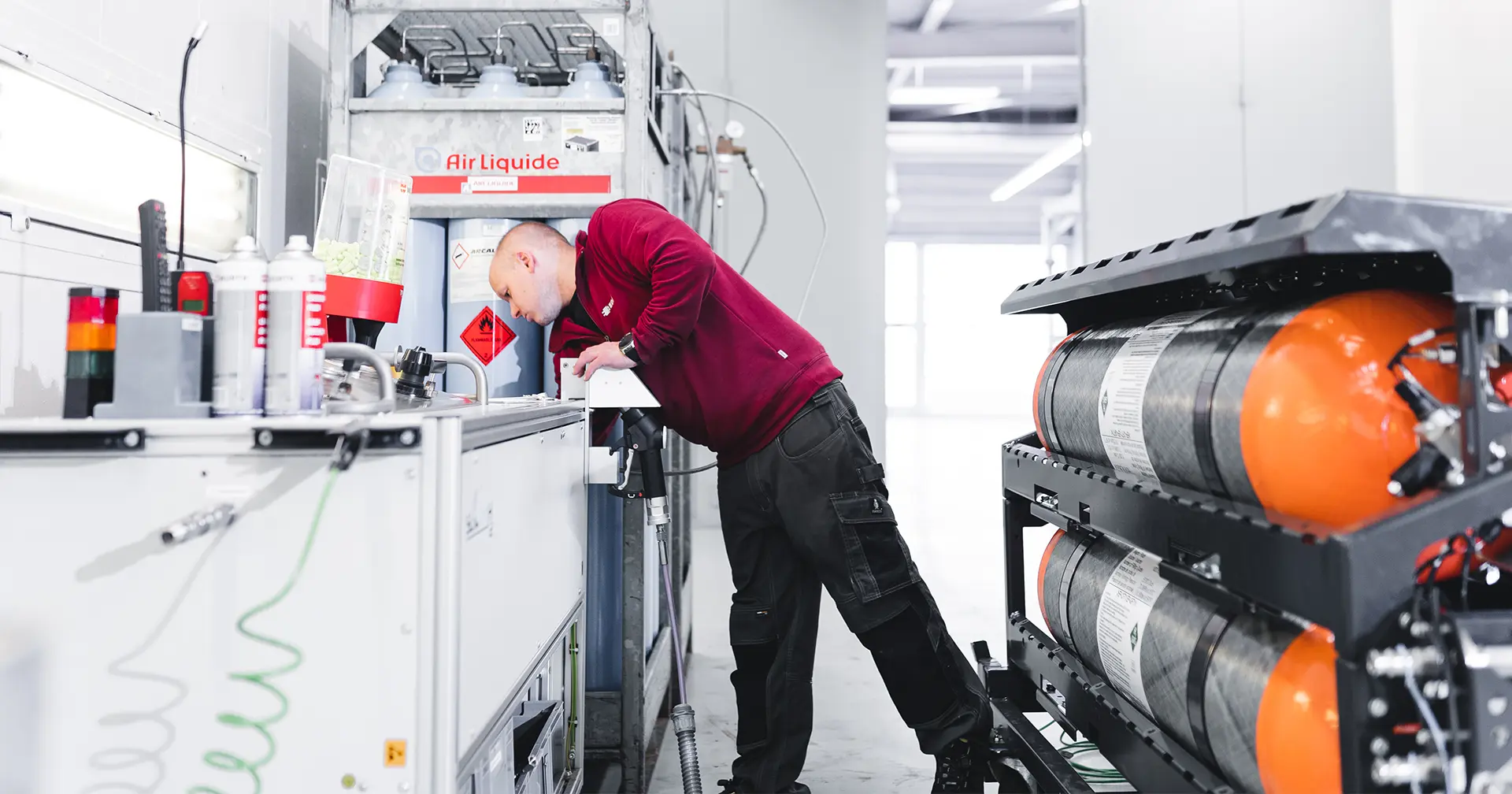It isn't just the lack of charging stations and the Deutschland-Ticket that made it clear: In rural areas, there is still much to do to move the mobility transition forward. Alternative forms of mobility such as sharing, on-demand or micromobility services could contribute to Smart Mobility in rural areas. But how can we bring them all together - and reach local citizens? The answer is: using customer-friendly mobility hubs.
On the way to a more climate-friendly transportation system, it is not enough to replace internal combustion vehicles with those powered by batteries. Programs such as the Deutschland-Ticket can help people switch from their cars to public transport, but only in places where buses and trains are available. In rural areas, where some towns and villages are only served by regular public transport once or twice a day, we need new concepts to ensure the mobility of the population and to offer a real alternative to motorized individual transport (MIT).
In fact, forms of mobility like Sharing-on-Demand or micromobility services are being established in many places. The crucial question is how people will accept these services. Topics such as visibility and information, but also the intelligent networking of the various services have a high impact. And last but not least, convenience for customers and improved social participation. In rural areas in particular, those responsible must finally present viable alternatives to the population, which has been isolated for many years, and thus expand their spaces of interaction.
The establishment of so-called mobility hubs increases the success of new offers in local public transport by serving as hubs and information centers for different mobility services, thus promoting multimodal transport services and intermodal transport behavior. In passenger transport, multimodality describes the use of alternative means of transport to travel different routes on different days. Intermodality describes the combined use of different means of transport for one journey - e.g. from home to work. As a result, the advantages of the different modes of transport can be combined.
Customer-friendly mobility hubs
The tasks of a mobility hub are exceedingly diverse. The decisions on the design have to be well planned and coordinated. Even its location in connection with existing smart mobility services is crucial for the attractiveness and acceptance of the mobility system. The new system should always consider and connect the entire infrastructure - public transport, waiting facilities, weather protection, parcel boxes or parking facilities.
Also, in terms of design, all services should be gathered "under one roof", but so that each element remains clearly identifiable. Everything must be coordinated - flooring, furniture, labeling, pictograms, color scheme and more. This facilitates access to the individual services and increases travel comfort. 
Furthermore, we have to understand mobility hubs as integrated components of a complete system of elements that can be experienced digitally, analogously and spatially. Travelers will only be able to understand and use this system well if everything is coordinated, and analog and digital relate to each other. This increases acceptance.
Smart mobility is digital
Another aspect of user acceptance is the software used. It should be based on a well-structured information architecture and a user-friendly interface that meets the highest standards of digital services. All elements should be clearly structured and show distances, times and prices as transparently as possible. Ideally, it corresponds to the analog information, labels and notes.
One challenge is to link the various mobility services in a practical way via software - a corresponding application has not been available until now. This has now changed: EDAG has just presented the "Open Mobility" framework. This system is able to aggregate a large number of different services and operators neutrally. The solution allows to add the services and functions available in each case modularly and to configure the white-label interface individually. This way, every municipality or region can publish a smartphone app of its own and support the operation of local mobility hubs with the services available in each case.
Therefore, the software ecosystem is a part of the individual, specific smart city strategy of a municipality, which integrates various elements. For example, an urban or municipal data platform as a central context data hub, a smart city dashboard for the operator side, and a smart mobility app for customers.
Support for municipalities and operators
The EDAG Group's experienced experts are working on numerous topics revolving around the modernization and digitalisation of transport in many respects. For example, in the development of smart mobility concepts for passenger transport and, in connection with this, the conception of the mobility hubs described above. Or with the appropriate digital infrastructure, in addition to the open mobility framework, e.g. on web applications and apps for users, and applications and dashboards for mobility hubs and mobility operators.
The mobility specialists also work on solutions for the transportation of goods in urban areas, such as urban logistics concepts, or sustainable mobility for industrial companies, including in rural areas. In one customer project, for example, a newly built industrial area was equipped with an e-truck sharing system that allows for environmentally friendly logistics without major investment costs on the part of the companies located there.
EDAG's services cover the entire development and implementation process. In this way, a technology benchmark can be created in advance, which draws an overview of the EU-wide provider landscape, including a comprehensive technology catalog. By selecting suitable funding programs and managing project proposals, the service provider can help close funding gaps. 
Conclusion
Rural areas urgently need intelligent mobility services based on a well-planned systemic structure. Various funding and networking options already exist at the state and federal level to plan and implement these projects in rural communities. The implementation is certainly challenging: Mobility requirements, specialist planning implementation, a sustainable energy concept and a smart software concept must be perfectly interlinked in order to create an overall concept that convinces people. Therefore, municipalities should take advantage of the experience of external partners to increase the likelihood of success.
If you have any questions about smart mobility concepts or would like any advice, talk to Judith Schultze, Business Development & Sales at EDAG Engineering. Or download our white paper: "Ways to Smart Mobility in Rural Areas". Here, you will find extensive information on what to consider when designing mobility hubs and the corresponding digital ecosystem.






